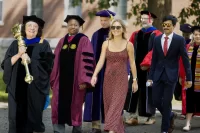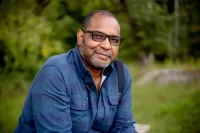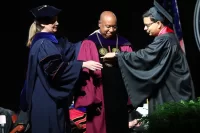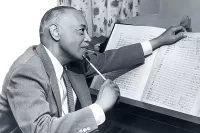
Commencement 2015: Manjul Bhargava’s address
A transcript of the 2015 Commencement address delivered by Manjul Bhargava, winner of the 2014 Fields Medal for mathematics and a professor at Princeton University.
President Clayton Spencer, Trustees, fellow honorary degree recipients, the professors and administrators and staff of Bates College who are present here today, and of course, most importantly, the Bates graduating class of 2015 and families. Congratulations and thank you so much. It’s such a great pleasure and honor to be here at this wonderful and storied liberal arts college on this grand occasion. I have to say I am such a big fan of all the honorary degree recipients that are here today — Mark Abelson, Thomas Moser, and Joan Benoit Samuelson — it’s really a true honor to be among them.
And it’s a real pleasure and honor to be giving this Commencement address on this occasion. It’s not often that a mathematician is asked to give a commencement address — perhaps this is for good reason! I suspect that when you all exited your last class here at Bates and were getting ready for graduation, you probably weren’t thinking, “I wish I could have had one more math class!” In case you were thinking this, your dream has just come true. No, I’m just kidding. I won’t be giving a math lecture today.
But I thought I would say a few words about some of those things that inspired me to go into mathematics and about some of the things that inspired today’s honorary degree recipients to do what they’re doing. And hopefully what will inspire many of you to do what you will eventually do.
Namely, I wanted to say a few words about the numerous remarkable relationships among different fields of human endeavor, the relationships that exist between mathematics and art, between sciences and the humanities — and more generally the surprising unity of all fields of human endeavor and what this all means in terms of the value of a liberal arts education, such as the one you received here at Bates. It’s something that I really believe you are so lucky and blessed to be walking out with today.
As you all know so well, liberal arts education allows one to learn and think critically across a wide range of disciplines. Of course, the overly pragmatic skeptic will always ask “But why do I need to know about disciplines that have nothing to do with the job that I’ll eventually work in?” Well, there are lots of answers to this question.
A liberal arts education allows one to learn and think critically across a wide range of disciplines.
First – and perhaps most importantly — it enriches your life; it makes life so much more interesting when you can appreciate worlds that are outside your own. But secondly, you never actually know what your job is going to be, or what your work will entail. Our own Joan Benoit Samuelson was a marathon runner — an Olympic gold medalist — but what she has done since then for young women, for children in general, and for the environment — all her vast philanthropic work — is even more impactful than her Olympic gold medal or her world records.
Our own Thomas Moser was a tenured associate professor here at Bates of rhetoric, and was the director of debate, before he became one of the world’s most artistic and beautiful furniture makers. As journalist Fareed Zakaria, who is a former Commencement speaker here, has emphasized many times, a liberal arts education prepares you not just for your first job, but for your second job and your third job and your fourth job and beyond.
And thirdly, even if you do know what your job will be for the rest of your life, you still never know when certain ideas and concepts from other disciplines might make an appearance in what you’re doing, in a way that could totally transform the work that you are doing or at least improve what you are doing.
Our own Dr. Mark Abelson here is a wonderful example of this. Dr. Abelson obtained several of his critical breakthroughs in ophthalmology by applying creative problem solving methods across a diverse range of disciplines including pharmacology, pathophysiology, economics, chemistry, cellular biology, and more. Indeed, many of the world’s greatest innovations and breakthroughs have occurred due to such cross-fertilization of ideas across seemingly different fields.
X-rays, CAT scans, MRIs, and lasers in medicine all originally came about due to physicists and space scientists thinking about these things for completely different reasons. In some cases, the immediate purpose was just to have fun and play around, which is what pure scientists generally are doing. Radiocarbon dating in archaeology, anthropology, and history is another example where ideas from physics and chemistry resulted in a revolution in fields that seemed completely different.
One of the main interests of mine, music, is another subject that has had incredibly interesting influences from many areas: psychology, physiology, sociology, engineering, physics, and mathematics. The choices of frequencies that sound good in music are governed by mathematical principles; two notes sound good together if their frequencies occur in a simple whole number ratio like 2:1, which is called an octave in music, or 3:2 which is called a fifth in music. These simple whole number ratios are what sound good to the human ear.
Many of the world’s greatest innovations and breakthroughs have occurred due to such cross-fertilization of ideas across seemingly different fields.
And so the manner in which these different notes were chosen in different musical cultures around the world, and how scales of entire notes were chosen in different musical cultures were chosen, they were chosen by basically the solution to a mathematical problem. How can you choose a set of notes so that all ratios of those frequencies that are occurring are simple whole number ratios? It’s a problem in number theory. And different solutions were obtained across different cultures. And that’s how music developed all around the word in different traditions.
I always found the study of this problem and its solutions through the ages, absolutely fascinating. For me personally, it is such unexpected connections, with art of all things, that brought me into mathematics in the first place.
In school, mathematics is usually grouped together with the sciences. But a lot of people don’t know that mathematics actually has a lot of its origins in music, in poetry, and the arts in general. These amazing connections are part of the reason I personally became interested in mathematics and ever since then, it has been one of my goals — one of my dreams — to get more young people interested in mathematics, not just through the sciences, but through the arts, through poetry, through music, through magic.
The reason it happened to me is that my grandfather was a scholar of Sanskrit and so a lot of what I learned about mathematics as a child was through what my grandfather taught me about the rhythms of Sanskrit poetry. The scientific setup of Sanskrit, both phonetically and poetically, naturally led early poets and linguists to consider various mathematical and scientific questions that one might not immediately expect from a poet.
There were, for example, questions relating to how many poetic meters there were of different types, how one could improvise on these meters and on these rhythms, and how one could use mathematical principles to memorize really long rhythms.
As a result, central concepts in mathematics, such as recurrent sequences like Fibonacci numbers, binomial coefficients, generative algorithms, memory wheels, and more, were first discovered in history in the context of poetry. And that made learning math so much fun for me, coming from an initial interest in poetry.
A lot of what I learned about mathematics as a child was through what my grandfather taught me about the rhythms of Sanskrit poetry.
The divide between poetry and math, at that time, was so thin that essentially all mathematics was actually written in poetry at the time. And a lot of poetry was written about mathematics. Some of these poems were full of vivid imagery of nature, and animals, and beautiful stories. And when reading some of these poems, which I often did as a child with my grandfather, often at the end one would realize that one had been tricked into learning a mathematical theorem, or had been asked a mathematical question that you couldn’t get your mind off afterwards and you had to solve.
I’ll give you an example. Here’s such a poem from Bhaskara’s Lilavati from the year 1150. It goes like this:
“The square root of half the number of bees has gone to a shrub of jasmine; and another eight-ninths of the whole swarm has gone there too; a female bee is buzzing towards a male bee that is itself buzzing within a lotus, having been allured to it by its fragrance at night. Tell me, O lovely maiden, the number of bees.”
In case you’re wondering, the answer is 72 bees.
These stories really inspired me when I was growing up because they were wonderful examples of simple ideas in one subject that eventually grew into concepts so omnipresent, important, and deep in another, in this case it was simple ideas in poetry, that led to deep and lasting ideas in mathematics.
These ideas are still used in breakthroughs today. So these stories illustrated and unravelled for me the beautiful and surprising connections among different realms of thought. And such stories still happen today. A lot.
Steve Jobs was famous for his ideas for products that married top-notch aesthetics with top-notch engineering. When asked about why the Macintosh computer revolutionized computing, he remarked, “I think part of what made the Macintosh so great was that the people working on it were musicians and poets and artists and zoologists and historians who also happened to be the best computer scientists in the world.” Many of the world’s greatest new companies and startups continue to follow this line of thinking, this marriage of different disciplines to achieve greater heights.
Creativity and technical know-how are both needed in this world, and are needed together.
I want to end with one last example that’s particularly relevant this week. One of my inspirations in graduate school, who later became a colleague, and in more recent years, someone I called my good friend, Professor John Nash and his wife Alicia, were killed in a car crash earlier this week.
It’s been an extremely devastating moment for all those who knew him, as well as for all those who knew his work, which is of course much of the world due to his tremendous creative influence across disciplines, as well as due to the movie that was loosely based on his life.
Professor Nash really personifies the notion that a simple idea in one subject can have profound effects on other areas. Despite all the hardships that he had to endure, and that we all at Princeton watched him endure, Professor Nash pursued what he enjoyed most: mathematics.
His theory of non-cooperative games — he was playing games for a living — and his theory of what’s now called the Nash equilibrium, was not only a work of technical mastery in mathematics, but also contained extremely artistic, creative ideas and constructions that were inspired by phenomena in neighboring disciplines. As a result, his work has had major influences on numerous subjects including economics, evolutionary biology, artificial intelligence, law, diplomacy, and politics.
We will truly miss Professor Nash, but it’s obvious from the work that he did for all of us that his legacy will live on strongly and forever. His story, and all the stories that I’ve mentioned today, clearly show that creativity and technical know-how are both needed in this world, and are needed together, and creativity or inspiration often comes from the connections, relations, and analogies that one sees with other subjects.
This is precisely why scientists ought to know about arts and the humanities, and similarly why artists and humanists should know about science. More precisely, that’s why it’s helpful for mathematicians to know about poetry and music; why it is helpful for sportspersons to know about environmental science and child welfare; why it is helpful for professors of rhetoric to know about woodworking; and why it’s so useful for doctors to know about economics in addition to the more traditional subjects for them like chemistry and biology; and why it can be useful for economists, biologists, and politicians to know about mathematics. And this is really what’s behind the value of a liberal arts education.
So, like Professor Nash and all the other wonderful people I’ve mentioned, find something that you really enjoy. In fact, find two or three or four or more things that you really enjoy and do them. Keep learning about other disciplines.
And don’t just appreciate the connections between different realms of human endeavor that you find but actively look for them, because they’re definitely out there. And use all these wonderful experiences, these things you enjoy, these connections, to find a job but beyond that, to do good work. In the language of Bates, to find your “Purposeful Work.”
To have fun, to make new friends, to take care of your family, your friends and others, and to do good work in the world. Of course, I believe the experiences that you’ve had at Bates already ideally prepare you to do exactly this.
Congratulations again Class of 2015. I can’t wait to hear about what you are going to do next, and best wishes for a very exciting array of future endeavors! Thank you so much.




